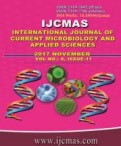


 National Academy of Agricultural Sciences (NAAS)
National Academy of Agricultural Sciences (NAAS)

|
PRINT ISSN : 2319-7692
Online ISSN : 2319-7706 Issues : 12 per year Publisher : Excellent Publishers Email : editorijcmas@gmail.com / submit@ijcmas.com Editor-in-chief: Dr.M.Prakash Index Copernicus ICV 2018: 95.39 NAAS RATING 2020: 5.38 |
The present investigation to assess genetic diversity among forty nine rice genotypes including four checks (FR13A, Hemavathi, Swarna Sub1 and Jyothi) was conducted at College of Agriculture, University of Agricultural and Horticultural Sciences (UAHS), Shivamogga during Kharif 2016. The clustering pattern based on Mahalanobis’ D2 analysis revealed that forty nine genotypes were grouped into eight clusters where cluster VI being the largest cluster with 10 genotypes and cluster I being the smallest (1 genotype). The maximum intra cluster distance was exhibited by cluster VII (98.11). The maximum inter cluster distance was recorded between cluster VII and cluster VIII suggesting that the genotypes constituted in these clusters can be used as parents for future hybridization programme, while the minimum was between cluster V and cluster VI (57.17). Cluster II had showed highest mean values for number of tillers per plant, number of productive tillers per plant, number of spikelets per panicle, number of filled grains per panicle, grain yield per plant, straw yield per plant. Traits like absolute growth rate, days to 50 per cent flowering, days to maturity, plant height, number of filled grains per panicle and grain yield per plant had contributed 95.24 per cent towards the total genetic divergence among the genotypes. Hence these traits should be given foremost importance while selecting parents in hybridization programme.
 |
 |
 |
 |
 |